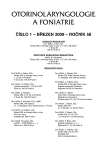-
Medical journals
- Career
Risk Factors and Prognostic Importance of Complications after Total Laryngectomy
Authors: Z. Čada 1; Martin Chovanec 1,2; J. Plzák 1,2,3; P. Balaži 4; J. Klozar 1
Authors‘ workplace: Klinika otorinolaryngologie a chirurgie hlavy a krku 1. LF UK a FN Motol, Praha, přednosta prof. MUDr. J. Betka, DrSc. 1; Anatomický ústav 1. LF UK, Praha, přednosta prof. MUDr. M. Grim, DrSc. 2; Centrum buněčné terapie a tkáňových náhrad 2. LF UK, Praha, přednostka prof. MUDr. E. Syková, DrSc. Fakulta jaderná a fyzikálně inženýrská ČVUT, Praha 3; vedoucí doc. Ing. M. Čech, CSc. 4
Published in: Otorinolaryngol Foniatr, 58, 2009, No. 1, pp. 3-7.
Category: Original Article
Overview
Total laryngectomy (TL) is increasingly performed as a life-saving procedure. The operation after radiotherapy (RT) or chemoradiotherapy (CRT) often heals for a long period of time and may be associated with a higher occurrence of complications, especially pharyngocutaneous fistulas (FP).
The objective of the work was to verify prevalence of FP in life-saving interventions in the authors’ own surgery data and to search for other risk factors of their origin. Another subject was to reveal whether prolonged healing influenced prognosis of the disease.
The retrospective study analyzed a cohort of 169 patients who underwent TL in the years 2002-2007. Statistical analysis of the data confirmed that preceding oncological therapy was an independent risk factor of the occurrence of FP (P=0.012). Surprisingly the strongest factor, influencing the development of fistula was the surgeon himself. The fistula occurred significantly less frequently in patients operated on by experienced surgeons (older than 35 years of age) in comparison with younger surgeons (P=0.006). Another factor which resulted in a higher occurrence of FP was the age group between 49 and 60 years (P=0.020). The occurrence of fistula did not influence the development of local recurrence (P-0.258) or overall survival (P=0.292).Key words:
total laryngectomy, pharyngocutaneous fistula, prognostic factors.
Sources
1. Myers, E. N., Suen, J. Y., Myers, J. N., Hanna, E. Y. N.: Cancer of the head and neck, Saunders, New York, 2003.
2. Thawley, S. E.: Complications of combined radiation therapy and surgery for carcinoma of the larynx and inferior hypopharynx. Laryngoscope, 91, 1981, s. 677-700.
3. Natvig, K., Boysen, M., Tausjw, J.: Fistulae following laryngectomy in patients treated with irradiation. J. Laryngeal. Otol., 107, 1993, s.1136-1139.
4. Weingrad, D. N., Spiro, R. H.: Complications after laryngectomy. Am. J. Surg., 146, 1983, s. 517-520.
5. Cummings, C. W., Johnson, J., Chung, C. K., Sagerman, R.: Complications of laryngectomy and neck dissection following planned preoperative radiotherapy. Ann. Otol. Rhinol. Laryngeal., 86, 1977, s. 745-750.
6. Redaelli de Zinis, L. O., Ferrari, L., Tomenzoli, D., Premoli, G., Parrinello, G., Nicolai, P.: Postlaryngectomy pharyngocutaneous fistula: Incidence, predisposing factors, and therapy. Head Neck, 21, 1999, s. 131-138.
7. Horgan, E. C., Dedo, H. H.: Prevention of major and minor fistulae after laryngectomy. Laryngoscope, 89, 1979, s. 250-258.
8. Papazoglou, G., Doundoulakis, G., Terzakis, G., Dokianakis, G.: Pharyngocutaneous fistula after total laryngectomy: Incidence, cause and treatment. Ann. Otol. Rhinol. Laryngol., 103, 1994, s. 801-805.
9. Seikaly, H., Park, P.: Gastroesophageal reflux prophylaxis decreases the incidence of pharyngocutaneous fistula after total laryngectomy. Laryngoscope, 105, 1995, s. 1220-1222.
10. Grau, C., Johansen, L. V., Hansen, H. S., Andersen, E., Godballe, C., Andersen, L. J..: Salvage laryngectomy and pharyngocutaneous fistulae after primary radiotherapy for head and neck cancer: A national survey from DAHANCA. Head Neck, 25, 2003, s. 711-716.
11. Aprigliano, F.: Use of the nasogastric tube after total laryngectomy: is it truly necessary? Ann. Otol. Rhinol Laryngol., 99, 1990, s. 513-514.
12. Lundgren, J., Olofsson, J.: Pharyngocutaneous fistulae following total laryngectomy. Clin. Otolaryngol., 1979, 4, s. 13-23.
13. Qureshi, S. S., Chaturvedi, P., Pai, P. S., Chaukar, D. A., Deshpande, M. S., Pathak, K. A., D’cruz, A. K.: A prospective study of pharyngocutaneous fistulas following total laryngectomy . J. Can. Res Ther., 2005, 1, s. 51-56.
14. Hier, M., Black, M. J., Lafond, G.: Pharyngo-cutaneous fistulas after total laryngectomy: Incidence, etiology and outcome analysis. J. Otolaryngol., 22, 1993, s. 164-166.
15. Markou, K. D., Vlachtsis, K. C., Nikolaou, A. C., Petridis, D. G., Kouloulas, A. I., Daniilidis, I. C.: Incidence and predisposing factors of pharyngocutaneous fistula formation after total laryngectomy. Is there a relationship with tumor recurrence? Eur Arch Otorhinolaryngol., 2004, 261, s. 61-67.
16. Virtaniemi, J. A., Kumpulainen, E. J., Hirvikoski, P. P., Johansson, R. T., Kosma, V. M.: The incidence and etiology of postlaryngectomy pharyngocutaneous fistulae. Head Neck, 2001, s. 29-33.
Labels
Audiology Paediatric ENT ENT (Otorhinolaryngology)
Article was published inOtorhinolaryngology and Phoniatrics

2009 Issue 1-
All articles in this issue
- Risk Factors and Prognostic Importance of Complications after Total Laryngectomy
- Minimal Retrosigmoidal Approach with Applied Endoscopy
- Surgical Treatment of Alar Insufficiency by Means of Rotation of Lateral Ramus of Alar Cartilage
- Dependence of the Amount of Cerumen on Anatomical Conditions in the Ear Canal
- Possibilities in the Therapy of Sudden Hearing Disorders
- Velo-pharyngeal Occlusion in Endoscopic Picture (1st part – theoretical introduction)
- Cholesteatoma of Eardrum Membrane: Congenital or Acquired?
- Pilomatricoma – Possible Cause of Swelling in the ORL Area
- Otorhinolaryngology and Phoniatrics
- Journal archive
- Current issue
- Online only
- About the journal
Most read in this issue- Pilomatricoma – Possible Cause of Swelling in the ORL Area
- Possibilities in the Therapy of Sudden Hearing Disorders
- Velo-pharyngeal Occlusion in Endoscopic Picture (1st part – theoretical introduction)
- Cholesteatoma of Eardrum Membrane: Congenital or Acquired?
Login#ADS_BOTTOM_SCRIPTS#Forgotten passwordEnter the email address that you registered with. We will send you instructions on how to set a new password.
- Career

